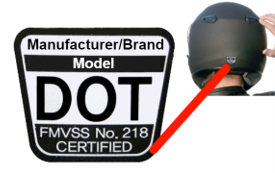Motorcycle riders continue to be overrepresented in fatal traffic crashes.1 In 2020, there were 5,579 motorcyclist deaths in the United States, 14% of all traffic fatalities.1 This is the highest number of motorcyclists killed since the Fatality Analysis Reporting System (FARS) started in 1975.2 In New Hampshire there were 21 total fatalities in 2020.3 To keep everyone safe, NHTSA is encouraging drivers and motorcyclists to share the road and be alert, and reminding motorcyclists to make themselves visible and to always use DOT-compliant motorcycle helmets, and to never drive impaired.
New Hampshire Crash Stats
 According to the National Highway Traffic Safety Administration (NHTSA), a motorcycle crash is a complex event involving the interaction of human, vehicle, and environmental factors.1 Per NHTSA the vehicle miles traveled in 2020, motorcyclists were about 28 times more likely than passenger vehicle occupants to die in a motor vehicle crash and were 4 times more likely to be injured.1 Being a safe motorcyclist takes balance, coordination, and good judgment.1
According to the National Highway Traffic Safety Administration (NHTSA), a motorcycle crash is a complex event involving the interaction of human, vehicle, and environmental factors.1 Per NHTSA the vehicle miles traveled in 2020, motorcyclists were about 28 times more likely than passenger vehicle occupants to die in a motor vehicle crash and were 4 times more likely to be injured.1 Being a safe motorcyclist takes balance, coordination, and good judgment.1
You can learn these tools by taking a motorcycle rider training program at the Division Motor Vehicle (DMV).
To sign up for a course or learn more please visit the New Hampshire DMV website.
 Of the motorcycle operators involved in fatal crashes in 2020, 36% were riding without valid motorcycle licenses. 1
Of the motorcycle operators involved in fatal crashes in 2020, 36% were riding without valid motorcycle licenses. 1
 Protect your brain by utilizing a motorcycle helmet that meets U.S. Department of Transportation (DOT) Federal Motor Vehicle Safety Standards (FMVSS) 218. Look for the DOT symbol on the outside back of the helmet. Snell and ANSI labels located inside the helmet also show that the helmet meets the standards of those private, non-profit organizations. Learn more about choosing the right helmet.
Protect your brain by utilizing a motorcycle helmet that meets U.S. Department of Transportation (DOT) Federal Motor Vehicle Safety Standards (FMVSS) 218. Look for the DOT symbol on the outside back of the helmet. Snell and ANSI labels located inside the helmet also show that the helmet meets the standards of those private, non-profit organizations. Learn more about choosing the right helmet.